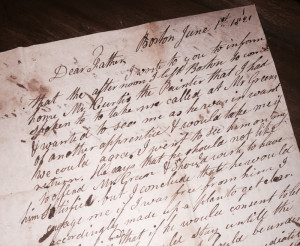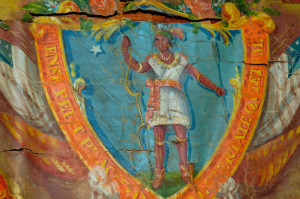True Tales from Canton’s Past: Crane Guards
By George T. ComeauThe entire village of South Canton gathered to see the militia in their stunning uniforms at the house of the general. On that Friday in October 1823, the trees dripped with red and gold and an autumn sun cast long shadows across Washington Street. The force was made up of many of the sons of the men that fought so valiantly in the Revolutionary War. Their fathers had marched on the alarm at Concord and had seen hardship and even death in faraway places that could hardly be comprehended by this new generation of young men in Canton.
And for these sons and brothers there was an overwhelming sense of duty, of pride, and dedication. They were known as Crane Guards, and they were attached to the Second Regiment, Second Brigade First Division of the Massachusetts Militia. They took their name from their benefactor and perhaps Canton’s best-known soldier at the time, General Elijah Crane. They were dressed in gray coats, white pantaloons, smart belts, and caps. In the fashion of the early uniforms of West Point, they were resplendent on that day.
Captain Elisha Crane stood at the head of the line, surrounded by his lieutenant and ensign. Eight noncommissioned officers stood in line, as the 29 privates, all quite young, stood at attention. The drummer snapped the hide of the large ornate wooden instrument as a fife played a march specially commissioned for the group. It was a sight to behold, and standing in front of the men were two women. One was Miss Eliza Capen, who had a silk cloth neatly folded in her hands. As she glanced at Captain Crane, anyone who was watching closely would have seen her eyes smile at him lovingly. At 25 they both had grown up in this same part of town. They had a shared history of their families’ connections in town. Perhaps that is one reason they were drawn to each other, aside from the fact that the young captain looked utterly handsome and she was modestly beautiful. Eliza and Elisha would be bound in marriage five years later.
To Eliza’s side was Mrs. Harriet Drake, the daughter of the general himself. And while these two women stood in front of the entire assembly, the day belonged to the major general. He was 68 years old, and the Canton we know today, along with the freedoms we enjoy, is because of his bravery and that of his father, Thomas Crane. The elder was an important man in the Revolutionary days of Stoughton and what is now Canton. The senior Crane served as justice of the peace, a delegate to the Second Provincial Congress in 1775, a selectman, and as a member of the General Court. Born in 1726 to Silas and Experience Crane in Milton, he lived in Ponkapoag and was one of our “most energetic and influential citizens.” The father had been on the committee that instigated the Minutemen, and the son had marched to Lexington in 1775. They were a power duo that together helped draw up the lines between Stoughton and what is now Canton.
General Crane became a man larger than life. In his day, his opinion was law, owing to the fact that he was the high sheriff in Norfolk County for 20 years. He had signed the petition to incorporate Canton and was the brigadier general of the Massachusetts Militia. And now in his late 60s, his hair was snow white, brushed straight up from his head. Bold and determined, with a square set jaw, the general stepped forth to review the militia that bore his name. His pride gleamed from his bright eyes as he nodded with assent to the two women. At the appointed time, young Eliza stepped forward and handed him the silk. The general’s words are not recorded, but in history we can surmise that he inspired these young men with words that would echo in their minds until they would draw their last breath. The general summoned the ensign forward, and taking a waiting oak staff, he fastened the silken ribbon ties to the pole in the fashion of the day. A strong breeze stirred the trees as Ensign Jeptha Crane raised the flag, a gift from the general to show his appreciation and esteem.
It was a glorious moment. High above the men flew their new banner — that of the Crane’s Guards. Imagine that moment 194 years ago, at the corner of Washington and Bolivar streets. Capture the image of that perfect autumn day in Canton’s history and know that on every face there was a smile.
The general had commissioned the flag sometime in 1822 or 1823. At the time there were only a handful of artists that were working in creating the military arts. On Washington Street, just past the high school is a beautiful brick federal house. At the time of the Crane Guards the house was owned by James Endicott, himself a captain in the Revolution and a man who fought at Lexington, Dorchester Heights, Cambridge, and Ticonderoga. Endicott had a son named George who, in 1821, was apprenticed in Boston to a house painter by the name of Mr. Green. In June, George had been approached by one of the Curtis brothers to see if he might be willing to leave the employ of Green and come over to a far more interesting business.

George Endicott wrote to his father in 1821 as he was about to embark on an “art that is the most delightful of all the arts.” (Collection of the Canton Historical Society)
S. and B.B. Curtis were ornamental painters and their specialties included ornamental signs, masonic painting, and glass as well as clock dials. But in particular they advertised as being experts in military standards. They were so busy that in 1822 they took on a partner named Charles Hubbard and became known as Curtises & Hubbard, taking up shop at 66 Market Street in Boston. George Endicott, at age 19, wrote in a letter dated June 1, 1821: “Dear Father … Mr. C’s terms will be as I expected, I shall have to stay a short time after I am free. I shall have a good opportunity to clothe myself … and more than that I shall learn an art which is the most delightful of all the arts in my esteem.”
And so, likely by midsummer, George Endicott was working for the finest painter of military flags and banners in New England. This seminal job would launch Endicott into the printing and lithography business where he would become one of the wealthiest men in New York. But in 1822, it was likely that he himself handled the Crane’s Guard Flag, for the connections between the town he grew up in and the military families is simply too strong to deny a plausible connection.
We have the drum; we have an epaulette, and a small leather case. We have recently found a sheet of music that was played perhaps that very day: “Crane’s Guard March.” But most importantly, we still have that flag. It is tattered and torn, and in deplorable condition. Like all artifacts of silk and thread, it has barely endured the test of time, light, and air. It had been found in Memorial Hall decades ago and destined for the town dump. Someone saved it and gave it to the Historical Society, where it was stored in the bottom of a drawer — an uncontrolled environment where it was crushed, folded, and left to decay. The silk is fractured and torn. Heavy black soot has turned the silk dark grey. There is tarnish and grime and the paintings are what hold it together, and therein lay the value of this item. The ground fabric is silk and metal thread, a satin weave with fragments of bullion metallic fringe. On the back of the flag it reads: “In-defense of Liberty,” “United we stand, divided we fall.” “Presented by Maj. Gen. Crane.” And there is a scene of the soldiers mustered in front of a small white church with the Blue Hill in the distance.
And on the front of the flag is perhaps the second oldest surviving painted Great Seal of the Commonwealth of Massachusetts. “By Arts and Arms we conquer,” “God armeth the patriot.” And the seal itself is beautiful — Indian, bow, arrow pointed down, in peace. This is one of our town’s greatest historical treasures and it sits at the edge of a great resurrection.
Next week at annual town meeting, voters will be asked to support the conservation of this flag using Community Preservation Act funds. This project is the essence of community, binding almost 200 years of history to the future for generations to come. The work to be completed is extensive and scientific. Microscopic fiber identification, humidification, surface cleaning painstakingly done under masterful hands. And when it is completed, a special case fitted with padded mounts will allow viewers to see both sides of this flag. The Crane’s Guard Flag will once again be a source of great pride just as it was in 1822. The memories of all that touched the flag, who mustered on that October day will come alive.
Short URL: https://www.thecantoncitizen.com/?p=33236











